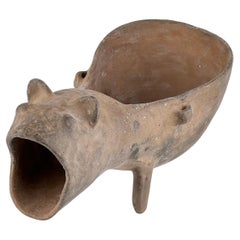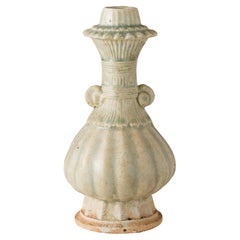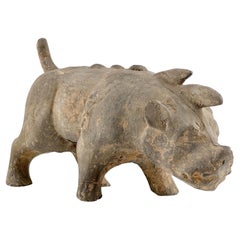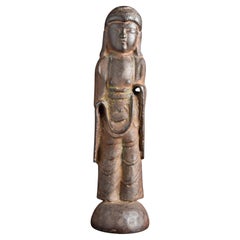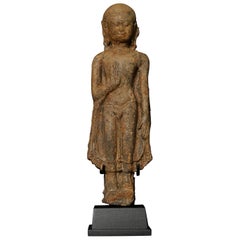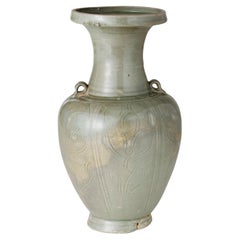18th Century and Earlier Antiquities
to
354
277
93
805
4
2
1
1
1
805
643
656
21
304
76
68
37
3
17
11
7
17
8
9
18
3
472
175
149
112
105
778
474
272
244
147
805
805
805
Period: 18th Century and Earlier
Earthenware Ewer, Yi
Located in seoul, KR
This terracotta vessel was fired to a warm yellow-brown that shows subtle oxidation marks across the surface. Entirely unglazed, it retains a matte, tactile finish with fine pores an...
Category
East Asian Antique 18th Century and Earlier Antiquities
Materials
Earthenware, Pottery
$1,300 Sale Price
35% Off
Porcelain with transparent pale-bluish (qingbai-type) glaze, Yuan Dynasty
Located in seoul, KR
This piece is shaped like a lotus bud, featuring a gracefully undulating body and intricate geometric patterns. The neck is adorned with finely incised dense lines, adding visual var...
Category
Hong Kong Antique 18th Century and Earlier Antiquities
Materials
Ceramic, Porcelain
$1,225 Sale Price
30% Off
A Grey Pottery Figure of Boar(Wild Pig), Han Dynasty
Located in seoul, KR
This piece is an ancient terracotta animal sculpture in the form of a pig, rendered in a simple yet vivid manner. The pig stands firmly on four stout legs, with a short and solidly m...
Category
Hong Kong Han Antique 18th Century and Earlier Antiquities
Materials
Pottery
$2,700 Sale Price
40% Off
13/14thC Large Thickly Cast Iron Korean Buddha, 9020
Located in Ukiah, CA
Very rare large thickly cast iron Korean Buddha (a magnet sticks to it). In an extremely early backless style. I believe this piece could be as late as 1...
Category
Korean Antique 18th Century and Earlier Antiquities
Materials
Iron
$10,075 Sale Price
35% Off
13thC Northern Thai Haripunchai Terracotta Standing Buddha-Rare - 7762
Located in Ukiah, CA
Rare 13thC Northern Thai Haripunchai terracotta standing Buddha. Extremely hard to find in complete condition. Significant wear, though the expressiv...
Category
Thai Antique 18th Century and Earlier Antiquities
Materials
Terracotta
Celadon Vase, Five Dynasties or Northern Song dynasty, 10th-11th Century
Located in seoul, KR
The form of Longquan celadon vases from the Northern Song dynasty evolved from an early design with a long neck and tapering body to a later ovoid body with a shorter neck. Over time, the glaze developed a more olive tone, and the carved decorations became more pronounced and intricate. Examples of such vases include one without a cover dated to the Yuanfeng era (1078~1085) and documented in literature, and another similar vase without loop handles preserved by the Qingyuan County Cultural Relics Bureau. An earlier example featuring loop handles and a lotus-like cover is also mentioned in historical texts.
The use of Longquan covered vases, especially as funerary jars for offerings like wine and grains, was highlighted by an inscription on a piece from the Sir Percival David Collection, London. This inscription wishes for the vessel to preserve fragrant wine for centuries, blessing the owner with prosperity, longevity, and a vast lineage, dated to the third year of the Yuanfeng period (1080). This practice was common in the regions of Southern Zhejiang and Northern Fujian. A similar celadon vase from the Linyushanren collection was auctioned at Christie’s Hong Kong, emphasizing the cultural and historical significance of these artifacts.
Period : Five Dynasties or Northern Song Dynasty
Type : Celadon, Zhejiang province
Medium : Celadon
Size : 31.5 cm(Height) x 11.5(Diameter)
Provenance : Acquired in late 1990s from Hongkong
Reference :
1) The British Museum image id - 01613270570
2) Christies New York 23–24 MAR 2023 - Important Chinese Ceramics and Works of Art - Lot 1012
(Price Range : USD 18,000 – USD 25,000 / Type : Related)
3) National Gallery of Victoria - Accession Number - AS5-1973
* Celadon from Five Dynasties (907~960) to the early Northern Song Dynasty (960~1127)
The period from the Five Dynasties (907~960) to the early Northern Song Dynasty (960~1127) marked a significant transitional phase in the development of Chinese celadon ceramics...
Category
Hong Kong Antique 18th Century and Earlier Antiquities
Materials
Celadon
$3,960 Sale Price
60% Off
Chinese Dian Culture Large Gold Cuff, circa 2nd Century BC, Southern China
Located in Austin, TX
A large and impressive solid high karat gold cuff from the Dian Kingdom, circa 2nd century BC, modern day Yunnan Province, China.
.
This striking cuff is crafted from hand hammered ...
Category
Chinese Han Antique 18th Century and Earlier Antiquities
Materials
Gold
Rare annamese cream glazed ewer, Vietnam, 11-15th century
Located in seoul, KR
Famous annamese cream glazed ceramic ewer covered with a cream glaze. Traces of excavation are clearly visible in the glaze.
Dates : Presumably Ly Dynasty (11-13th century)
Region ...
Category
Vietnamese Antique 18th Century and Earlier Antiquities
Materials
Ceramic, Stoneware
A Japanese Samurai ressei menpo mask
Located in Milano, IT
Samurai menpo mask with the ressei (fierce) expression, belonging to the me-no-shita "half-face" type, which stands out for its leather surface to simulate ...
Category
Japanese Japonisme Antique 18th Century and Earlier Antiquities
Materials
Leather
$4,434 Sale Price
20% Off
Rare Famille Rose/Verte Shipwreck Ceramics Set, Qing Dynasty, Yongzheng Era
Located in seoul, KR
Beautiful 'chickens and flowers' painted rare familie rose/verte ceramic set from Qing dynasty. Excavated from cargo underwater from the early Qing dynasty. It is presumed to originate from the Yongzheng period Ca Mau Shipwreck. On the back of the baluster vase, there are traces of marine organisms. This type of famille porcelain...
Category
Vietnamese Qing Antique 18th Century and Earlier Antiquities
Materials
Ceramic
$2,660 Sale Price / set
30% Off
Early Chinese/Silk Road, Bronze Buddha/Bodhisattva Bust-Possibly 10thC or e 9687
Located in Ukiah, CA
Early Chinese/Silk Road. Bust alone stands 7.5 inches tall. The crown, face, and overall look suggest an extremely early dating-possibly over 1000 years old. . Extremely powerful pre...
Category
Chinese Antique 18th Century and Earlier Antiquities
Materials
Bronze
Han Cocoon Shaped Vessel
Located in Coral Gables, FL
Han dynasty, China, circa 200 BC to 2 AD.
Category
Chinese Other Antique 18th Century and Earlier Antiquities
Materials
Earthenware
$5,000
Two Pair of Annamese Porcelain Crab Boxes, 15th century, Le Dynasty
Located in seoul, KR
Vietnamese stoneware crab boxes. Light blue glaze. This is one of the representative types of miniature works of Hoi An ships.
Dates : 15th century Le Dyn...
Category
Vietnamese Antique 18th Century and Earlier Antiquities
Materials
Ceramic, Porcelain
$1,953 Sale Price
30% Off
A Zhejiang Porcelain Ewer, Northern Song Dynasty
Located in seoul, KR
The oviform body is divided into few lobes. All covered in a finely crackled pale olive-green glaze. The surface and glaze characteristics are definitive, confirming the authenticity...
Category
Hong Kong Antique 18th Century and Earlier Antiquities
Materials
Porcelain
$2,925 Sale Price
35% Off
Three Annamese Small Blue Lidded Boxes, 15th century, Le Dynasty
Located in seoul, KR
These are three small lidded boxes from the Vietnamese period, specifically from the 15th century during the Le Dynasty.
Dates : 15th century Le Dynasty
Region : North Annam, Viet...
Category
Vietnamese Antique 18th Century and Earlier Antiquities
Materials
Ceramic
$954 Sale Price / set
40% Off
Cizhou slender meiping, Yuan Dynasty
Located in seoul, KR
The elongated body is fluidly painted in brown on a white slip and under a clear glaze with a broad band of abstract floral scroll between a band of upright petals below and further ...
Category
Hong Kong Other Antique 18th Century and Earlier Antiquities
Materials
Stoneware
$7,996 Sale Price
60% Off
Blue and White Porcelain Meiping Vase with Peony Scroll, Ming Dynasty
Located in seoul, KR
This piece is presumed to be a blue and white porcelain meiping vase from the mid-Ming Dynasty. The entire body is decorated with arranged peony scrolls painted in underglaze cobalt ...
Category
East Asian Ming Antique 18th Century and Earlier Antiquities
Materials
Ceramic
Korean Goryeo Bronze Bottle Vase with Green Patina, 12th/13th Century
Located in Austin, TX
An elegant and unusually large Korean Goryeo bronze bottle vase with green patina, Goryeo Dynasty, 12th/13th century, Korea.
The graceful vase of typical bottle form, with a bulbous...
Category
Korean Antique 18th Century and Earlier Antiquities
Materials
Bronze
12th Century, Angkor Vat, A Pair of Antique Khmer Bronze Hand Bells with Stand
Located in Sampantawong, TH
A pair of Khmer bronze hand bells with very nice patina.
Age: Cambodia, Angkor Vat Period, 12th Century
Size: Height 12.8 - 14 C.M. / Width 6.5 - 7.8 C.M.
Size including stand: Heig...
Category
Cambodian Antique 18th Century and Earlier Antiquities
Materials
Bronze
$1,072 Sale Price / set
20% Off
Large Changsha Bowl from Belitung Ship, Tang Dynasty
Located in seoul, KR
The edges have been dipped in four places with brown, probably iron-oxide. The well of the bowl is freely painted in deep green and coffee coloured brown. These are characteristic fe...
Category
Indonesian Tang Antique 18th Century and Earlier Antiquities
Materials
Pottery
$2,800 Sale Price
30% Off
A Large and Rare Straw-Glazed Pottery Amphora, Tang Dynasty
Located in seoul, KR
The ovoid shape suggests the influence from “amphora” of Greece and Rome, while the dragon-shaped handles allude to Persian and Central Asian metalwork. The ubiquitous dragon is a Ea...
Category
Hong Kong Tang Antique 18th Century and Earlier Antiquities
Materials
Pottery, Stoneware
$8,125 Sale Price
35% Off
Blue and White Baluster Vase, Qing Dynasty, Kangxi Era, Circa 1690
Located in seoul, KR
The baluster shaped vase rising from a splayed foot to a short waisted neck, decorated in underglaze blue with flower blooms borne on leafy stems.
Period : Qing Dynasty, Kangxi reign
Production Date : 1690-1699
Made in : Jingdezhen
Destination : Amsterdam
Found/Acquired : Southeast Asia , South China Sea, Vung Tau...
Category
Vietnamese Chinoiserie Antique 18th Century and Earlier Antiquities
Materials
Ceramic
17C SE Asian Indian Pair of Brackets with Elephants and Mahuts
Located in Dallas, TX
Presenting a stunning piece of Indian antiquity from the 17th century, namely, a pair of red Sandstone brackets with elephants and mahuts Central India carvings.
From Central India.
This piece has impeccable Provenance !
It was purchased by a Private Dallas Collector at Sotheby’s New York Auction on 15th October 2001. Sale Number 7694, Lot No. 102.
Sotheby’s operate a twice yearly auction of Southeast Asian Art & Antiquities in New York in the months of March and September.
The sculpture was described as: “A pair of brackets with elephants and mahuts.
Red Sandstone.
Central India.
17th century.”
It carried an Auction estimate of USD 8,000 to USD 10,000 and sold for USD 8,400 (not including buyers...
Category
Indian Archaistic Antique 18th Century and Earlier Antiquities
Materials
Sandstone
$26,600 Sale Price / set
30% Off
Changsha Bowl from Belitung Ship, Tang Period
Located in seoul, KR
The back side edges have been dipped in four places with brown, probably iron-oxide. The well of the bowl is freely painted in deep green and coffee coloured brown. These are charact...
Category
Indonesian Tang Antique 18th Century and Earlier Antiquities
Materials
Pottery
$1,950 Sale Price
35% Off
Japanese Samurai Figure Hinaningyo, Edo Period
Located in Munich, Bavaria
Antique samurai doll called Hinaningyo; Japan, late EDO period
Praised at the Tang-no-sekku boys' festival on May 5th as a sign of bravery, embodying the...
Category
Japanese Antique 18th Century and Earlier Antiquities
Materials
Textile, Wood
$2,669 Sale Price
20% Off
Rare 'Imari Pavilion' Blue And White Tea Set C 1725, Qing Dynasty, Yongzheng Era
Located in seoul, KR
The "Imari Pavilion pattern" refers to a decoration pattern found on porcelains made during Early Qing Dynasty, influenced by Japanese Imari ware, which was produced in the Arita reg...
Category
Vietnamese Qing Antique 18th Century and Earlier Antiquities
Materials
Ceramic
$2,310 Sale Price / set
30% Off
16th Century Pottery Model of a Folding Chair, Ming dynasty
Located in seoul, KR
This piece is an example of Mingqi, items specifically crafted for burial to accompany the deceased into the afterlife. The terracotta army is the most renowned example of such buria...
Category
Hong Kong Ming Antique 18th Century and Earlier Antiquities
Materials
Pottery
$903 Sale Price
35% Off
Japanese Primitives Antiques : Hearth Tools Fish-shaped wood Hook Farmer Life
Located in Niiza, JP
A tool used to hang a kettle from the ceiling above a hearth is called a Jizai-kagi(自在鉤).
This is a part called a Yokogi(横木) that is used to adjust the length of the hook.
It has bee...
Category
Japanese Antique 18th Century and Earlier Antiquities
Materials
Wood
19th Century Chinese Ginger Jars
Located in Esbeek, NL
Beautiful set of Chinese ginger jars
18th century or earlier.
Category
Chinese Antique 18th Century and Earlier Antiquities
Materials
Porcelain
$7,075 / set
Gate Pillar, Han Dynasty(206BC-220AD)
Located in seoul, KR
The Han Dynasty gate pillar held by the Asian Art Museum in San Francisco and this gate pillar are the only known examples of their type worldwide, highlighting its extraordinary rar...
Category
Hong Kong Han Antique 18th Century and Earlier Antiquities
Materials
Earthenware
$5,985 Sale Price / set
25% Off
Hu vase with green glaze, Han Dynasty
Located in seoul, KR
It is made from a fairly high-fired reddish pottery and coated in a particularly attractive glossy thick streaky green and finely-crackled glaze, the colour of which varies according...
Category
Hong Kong Han Antique 18th Century and Earlier Antiquities
Materials
Stoneware
$2,992 Sale Price
25% Off
18th Century, Shan, Antique Burmese Wooden Seated Buddha
Located in Sampantawong, TH
Antique Burmese wooden Buddha sitting in Mara Vijaya (calling the earth to witness) posture on a base.
Age: Burma, Shan Period, 18th Century
Size: Height 58 C.M. / Width 20 C.M. / D...
Category
Burmese Antique 18th Century and Earlier Antiquities
Materials
Wood
Gandharan Stucco Head of a Donor, 4th-5th Century
Located in Austin, TX
A sublime molded stucco head of a young male donor from the ancient region of Gandhara, 4th-5th century.
The youthful nobleman sculpted in an idealized...
Category
Pakistani Hellenistic Antique 18th Century and Earlier Antiquities
Materials
Stucco
A large Dutch colonial ebony cabinet with brass mounts
Located in Amsterdam, NL
A Dutch colonial ebony cabinet with brass mounts on contemporary black steel frame
Batavia (Jakarta), 2nd half 17th century
The cabinet has two ...
Category
Indonesian Dutch Colonial Antique 18th Century and Earlier Antiquities
Materials
Brass
Earthenware Pottery Jar, Han Dynasty(206 BC-220 AD)
Located in seoul, KR
This jar would have served as a mortuary object (mingqi), placed in a tomb as a substitute for the more valuable bronze and lacquer vessels. Along with a variety of other funerary earthenware objects, attendant figures, and animals, richly decorated vessels of this kind were intended to serve the spirit of the deceased in the afterlife.
Period : Han dynasty
Type : Jar
Medium : Earthenware
Dimension : 28.5 cm(Height) x 11cm(Mouth Diameter)
Condition : Good(Overall in well-preserved ancient burial condition with some soil still adhering (showing minor abrasions and wear due to prolonged burial underground)
Provenance : Acquired in late 1990s from Hongkong
* Han Dynasty Earthenware...
Category
Hong Kong Han Antique 18th Century and Earlier Antiquities
Materials
Earthenware
$2,093 Sale Price
30% Off
18th Century Set of 8 Chinese Silver Lacquer Bowls with Mother of Pearl Inlaid
Located in Brea, CA
A fine set of 8 pieces Chinese lacquered and mother of pearl inlaid bowls with silvered interiors from the 18th century Qing Dynast...
Category
Chinese Ming Antique 18th Century and Earlier Antiquities
Materials
Lacquer
Blue And White Vase, Qing Dynasty, Kangxi Era, Circa 1690
Located in seoul, KR
Vung Tau Shipwreck Coralized Blue Underglazed Porcelain Lidded Vase. Almost perfectly Identical piece from Vietnamese Royal Family in United States provenance have been sold at other auction in California. This stunning porcelain lidded vase is elaborately decorated in a vivid blue underglaze with an ornate scene of concubines in a flower garden. The bottom of the vase bears a conch marking in underglazed blue, is a symbol of royalty, dignity and high rank, the 'Sacred Lungs of Buddha' and spiritual authority.
Period : Qing Dynasty, Kangxi reign
Production Date : 1690-1699
Made in : Jingdezhen
Destination : Amsterdam
Found/Acquired : Southeast Asia , South China Sea, Vung Tau Ship
Reference : Double checked with reference to the original catalogues
1) Christies Amsterdam 1992 - Vung Tau Cargo...
Category
Vietnamese Qing Antique 18th Century and Earlier Antiquities
Materials
Ceramic
$1,885 Sale Price
35% Off
Teapots with Cover from Ca Mau Ship, Qing Dynasty, Yongzheng Reign
Located in seoul, KR
The teapot on the left features a rounded body densely adorned with blooming flowers and intertwining vines, creating a flowing and repetitive pattern. The delicate brushstrokes emph...
Category
Vietnamese Qing Antique 18th Century and Earlier Antiquities
Materials
Ceramic
$1,820 Sale Price / set
35% Off
17-19thC Antique Tibetan Altar, 8193
Located in Ukiah, CA
17-19thC Antique Tibetan altar from the estate of the great comedian Gary Shandling. The main part of the altar looks to be quite early based on...
Category
Tibetan Antique 18th Century and Earlier Antiquities
Materials
Wood
$11,375 Sale Price
35% Off
Archaic Jade Bi, Zhou Dynasty
Located in Atlanta, GA
Translucent green and brown jade Bi from the Zhou Dynasty (1046 B.C. to 256 B.C.). The organic shapes created by the blending of these two main colors evoke a flame-like beauty, whil...
Category
Chinese Antique 18th Century and Earlier Antiquities
Materials
Jade
6 Elegant Ming Dynasty Court Attendants in Glazed Terracotta, China 1368-1644 AD
Located in San Pedro Garza Garcia, Nuevo Leon
A fine set of a six court attendants as in the Forbidden City of Beijing, elegantly dressed in a Green & Red Daopao – a traditional men’s formal attire from the Ming Dynasty dated 1368-1643 A.D. – with glazed robes and Red Pigment remains in their hat and belts. They stand in an honorary posture atop a red plinth, some with orifices in their hands, where spirit objects were placed to comfort or satisfy the deceased. The heads are detachable, as often seen on the larger figures from this period.
They are accompanied by a Certificate of Authenticity, and Certificate of Expertise by Jean-Yves Nathan - a leading authority specialized in Far East Archaeology from the CEDEA (The European Confederation of Art Experts).
Burial figurines of graceful dancers, mystical beasts, and everyday objects reveal both how people in early China approached death and how they lived. Since people viewed the afterlife as an extension of worldly life, these figurines, called mingqi, sometimes referred as “spirit utensils” or “vessels of ghosts” disclose details of routine existence and provide insights into belief systems over a thousand-year period.
The Ming dynasty was the ruling dynasty of China – then known as the Empire of the Great Ming – for 276 years (1368–1644 AD). Founded by Chu Yuan-chang, the rebel leader that was successful in removing the mongols from the throne. Chinese control was re-asserted in China and eastern Asia. Literature became more important, schools were created, and the justice system was reformed. The Ming dynasty is described by some as "one of the greatest eras of orderly government and social stability in human history,” was the last imperial dynasty in China ruled by ethnic Han Chinese.
The practice of burying ceramic objects with the deceased went into decline from the 10th to the 14th Century AD. There was a revival in placing miniature representations of glazed terracotta objects such a furniture, food offerings, horses, miniature statues...
Category
Chinese Ming Antique 18th Century and Earlier Antiquities
Materials
Terracotta
18th Century Small Black Jewelry Chest
Located in Dallas, TX
This old wooden chest was probably a jewelry box back in the day. It was painted in black then hand painted with decor and organic forms throughout. The two wooden front doors...
Category
Asian Antique 18th Century and Earlier Antiquities
Materials
Wood, Paint
Annamese Dish Circa 15th Century, Le Dynasty
Located in seoul, KR
Its surface is coated with a smooth, glossy white or cream-colored glaze, exuding a clean and elegant finish. At the center, a geometric motif painted in black pigment draws the eye,...
Category
Vietnamese Antique 18th Century and Earlier Antiquities
Materials
Stoneware
$1,500 Sale Price
40% Off
Superb Set of 5 Elegant Court Attendants, Ming Dynasty, 1368-1644 AD TL Tested
Located in San Pedro Garza Garcia, Nuevo Leon
A stunning set of 5 graceful terracotta figurines from the Ming Dynasty '1368-1644' AD. These elegant attendants are standing on a yellow glazed lotus flower over a high hexagonal green plinth and wear fine robes in matching green and yellow glazes. The unglazed areas have pigmented colors in red, black and white. Each is carrying essential offerings for the royal family. The head is detachable as often seen on the larger figures from this period. Meticulously detailed facial expressions have been hand-painted.
Condition: Mint, finely preserved glaze and pigment, undamaged and no repairs.
Provenance: Ex. Danish Collection.
This set is guaranteed authentic and comes with a Certificate of Authenticity and TL Test from Laboratory Kotalla in Germany (The Oldest Thermoluminescence Testing Laboratory in the World).
Dimensions: Average 54 H cms
Burial figurines of graceful dancers, mystical beasts, and everyday objects reveal both how people in early China approached death and how they lived. Since people viewed the afterlife as an extension of worldly life, these figurines, called mingqi, sometimes referred as “spirit utensils” or “vessels of ghosts” disclose details of routine existence and provide insights into belief systems over a thousand-year period.
The Ming dynasty was the ruling dynasty of China – then known as the Empire of the Great Ming – for 276 years (1368–1644 AD). Founded by Chu Yuan-chang, the rebel leader that was successful in removing the mongols from the throne. Chinese control was re-asserted in China and eastern Asia. Literature became more important, schools were created, and the justice system was reformed. The Ming dynasty is described by some as "one of the greatest eras of orderly government and social stability in human history,” was the last imperial dynasty in China ruled by ethnic Han Chinese.
The practice of burying ceramic objects with the deceased went into decline from the 10th to the 14th Century AD. There was a revival in placing miniature representations of glazed terracotta objects such a furniture, food offerings, horses, miniature statues...
Category
Chinese Ming Antique 18th Century and Earlier Antiquities
Materials
Terracotta
Two Figures of Attendants, Ming Period(1368-1644)
Located in seoul, KR
Statues of attendants crafted from terracotta, featuring glazes in green, Set on rectangular bases.
Period: Ming Dynasty
Medium: Glazed Pottery
Type: Figure
Condition : Excellent(It has soil on it, which is presumed to be evidence of excavation)
Provenance : Acquired in late 1990s from Hongkong
Reference :
1) Indianapolis Museum of Art - Dinastia ming, figure maschili, 1368-1644
(Type : Closely related)
2) V&A Museum - Accession number FE.295:1, 2-2005
(Type : Closely related)
3) Sotheby's 01 May 2007 - The Collection Of Paul Otto Taubert & Jewellery And Decorative Arts - Lot 233
(Price range : 5,000 - 7,000 AUD / Type : Closely related)
4) Asian Art Museum, San Francisco - Object number B60P1631 - Standing Man Tomb Figure
* Ming Dynasty Glazed Pottery Figures
Ming Dynasty glazed pottery figures are renowned for their bold color palette, intricate detailing, and lifelike forms, distinguishing them from earlier traditions. These figures, which depict officials, warriors, animals, and mythical creatures, are characterized by high-gloss lead-based glazes in green, amber, ochre, and sancai (three-color) combinations. The thickly applied glaze pools in recesses, creating depth and enhancing sculptural details. With dynamic postures, expressive facial features, and meticulously rendered drapery, these figures reflect the period’s advancement in ceramic craftsmanship, offering a greater sense of movement and realism compared to the rigid and stylized forms of earlier dynasties.
A defining characteristic of Ming glazed pottery is its elaborate surface detailing, often achieved through raised relief elements and contrasting glazes. Equestrian figures, for example, feature carefully sculpted saddles, harnesses, and decorative embellishments, while human figures are adorned with intricate robes and headdresses. The large scale of these tomb figures, often more imposing than those from previous periods, underscores the increasing importance of funerary art during the Ming era. Unlike later Qing Dynasty figures...
Category
Hong Kong Ming Antique 18th Century and Earlier Antiquities
Materials
Pottery
$1,820 Sale Price
35% Off
Five Green Glazed Pottery Attendant Figures, Ming Dynasty(1368-1644)
Located in seoul, KR
The three figurines in the back exhibit the typical form of attendants, wearing conical red hats and adopting poses where their right hands are either held in front of their chests o...
Category
Hong Kong Ming Antique 18th Century and Earlier Antiquities
Materials
Pottery
$2,925 Sale Price / set
35% Off
A Han (206BC -220AD) Glazed Hu Vessel
Located in Chicago, IL
This is a fine, heavily patinated example of a Han hu wine storage vessel, buried for the afterlife. The compressed globular body narrows to a slender waisted neck, covered with a da...
Category
Chinese Han Antique 18th Century and Earlier Antiquities
Materials
Terracotta
Three Annamese Small Yuhuchunping, 15th century, Le Dynasty
Located in seoul, KR
These 15th-century Annamese ceramics from Le dynasty, are notable for their rarity and refined design. The Yuhuchunping vases, with their elegant pear-shaped bodies and delicate blue-and-white motifs, showcase the sophisticated craftsmanship of the time. They offer a glimpse into the vibrant maritime trade networks of Southeast Asia during the 15th century, making them valuable artifacts in the study of East Asian ceramics...
Category
Vietnamese Antique 18th Century and Earlier Antiquities
Materials
Ceramic
$1,800 Sale Price / set
40% Off
China 960 Ad Song Dynasty Very Rare Imperial Period Offering Vessel in Bronze
Located in Miami, FL
Offering vessel from the Chinese Song Dynasty (960/1279 AD ).
A beautiful "offering spiritual vessel" from the Yunnan province region in the ancient China. This rare vessel was created in red bronze during the Song Dynasty period. between 960/1279 AD.
This is one of the most unusual forms of red bronze jar. A large vessel, the sides are virtually perpendicular to the base. The stepped lid design is also among the more rare types. The predominant lid design among the Yunnan offering bronzes is the "wheel" pattern, with a few lids having the lotus design. This is also one of the few bronzes displaying clear riveting of a two-part vessel body, with the original twisted elements
Has a combined measures including the lid of 12.5 by 8.75 inches (31.75 x 22,23 Cm).
The Song Dynasty, was an imperial dynasty of China that began in 960 and lasted until 1279. The dynasty was founded by Emperor Tizu of Song following his usurpation of the throne of the later Zhou, ending the Five-Dynasties and Ten Kingdoms period. The Song often came into conflict with the contemporaneous Liao, Western Xia and Jin dynasties in northern China. After decades of armed resistance defending southern China, it was eventually conquered by the Mongol-led Yuan dynasty.
The dynasty is divided into two periods: Northern Song and Southern Song...
Category
Chinese Medieval Antique 18th Century and Earlier Antiquities
Materials
Bronze
$3,960 Sale Price
20% Off
Chinese Tang Dynasty Pottery Court Lady
Located in Austin, TX
Painted pottery figure of an opulent Chinese court woman with up-swept hair and standing in a simply draped robe from the Tang Dynasty (618-907 AD). Her beauty is illuminated by the ...
Category
Chinese Tang Antique 18th Century and Earlier Antiquities
Materials
Pottery, Acrylic
Large Pottery Standing Figure of Attendant, Han dynasty
Located in seoul, KR
The statuette shows traces of the original red, black, and white pigmentation. The figure’s body, head, and hands (which in this case are lost) were all made separately to give her an essence of movement and dynamism. Given its almost identical shape to the piece from the Artemis Gallery...
Category
Hong Kong Han Antique 18th Century and Earlier Antiquities
Materials
Pottery
$2,334 Sale Price
34% Off
Funerary Model of a Granary, Han dynasty
Located in seoul, KR
Cylindrical vessel on three animal-shaped feet (dragon or snake), wall with profile grooves, roof. pottery with green lead glaze. "Iridescence" is observed in surface.
Period : Han...
Category
Hong Kong Han Antique 18th Century and Earlier Antiquities
Materials
Pottery
$1,400 Sale Price
30% Off
Pottery Tripod Vessel, Neolithic Period
Located in seoul, KR
The sturdy triangular legs, wide mouth, convex body, and diagonal incised patterns create a harmonious balance, showcasing a form that is both primitive and refined. Notably, the twi...
Category
Hong Kong Antique 18th Century and Earlier Antiquities
Materials
Earthenware, Pottery
$1,400 Sale Price
30% Off
A Dutch colonial ebony box with silver mounts
Located in Amsterdam, NL
Batavia (Jakarta), or Sri Lanka, circa 1680-1720
The document or money box is densely carved with fine scrolling vines and lotus flowers. It has a charming heart- shapes silver lock...
Category
Indonesian Dutch Colonial Antique 18th Century and Earlier Antiquities
Materials
Silver
16/17thc Tibetan Bronze Skull Cup - 9026
Located in Ukiah, CA
15-17thC Tibetan Bronze Skull Cup. Quite Large for its type (nearly life-size) at 8 inches deep, 6 inches wide, and pproximately 5 inches tall. IT is 9 7/8...
Category
Tibetan Antique 18th Century and Earlier Antiquities
Materials
Bronze
Green Glazed Horse and Rider, Ming period(15-16th Century)
Located in seoul, KR
Statues of East Asian horse rider, featuring glazes in green, are set on rectangular base.
Period: Ming Dynasty
Medium: Green-glazed Pottery
Type: Figure
Condition : Good
Provenance : Acquired in early 2000s from Hongkong
* Ming Dynasty Glazed Pottery Figures
Ming Dynasty glazed pottery figures are renowned for their bold color palette, intricate detailing, and lifelike forms, distinguishing them from earlier traditions. These figures, which depict officials, warriors, animals, and mythical creatures, are characterized by high-gloss lead-based glazes in green, amber, ochre, and sancai (three-color) combinations. The thickly applied glaze pools in recesses, creating depth and enhancing sculptural details. With dynamic postures, expressive facial features, and meticulously rendered drapery, these figures reflect the period’s advancement in ceramic craftsmanship, offering a greater sense of movement and realism compared to the rigid and stylized forms of earlier dynasties.
A defining characteristic of Ming glazed...
Category
Hong Kong Ming Antique 18th Century and Earlier Antiquities
Materials
Pottery
$1,625 Sale Price
35% Off
Song Dynasty, Antique Chinese Pottery Brick Tile with Musician Flute Player
Located in Sampantawong, TH
Antique Chinese pottery brick tile with musician flute player.
Age: China, Song Dynasty, 10th - 12th Century
Size excluding stand: Height 31.6 C.M. / Width 18.8 C.M.
Height includin...
Category
Chinese Antique 18th Century and Earlier Antiquities
Materials
Pottery
Bactrian Marble Column Idol
Located in Vosselaar, BE
Bactrian marble column idol, circa 3000-2000 Bc. It has a elegant tapering form with a undeep groove running on the top and bottom. The marble is a breccia type with striking vains i...
Category
Afghan Archaistic Antique 18th Century and Earlier Antiquities
Materials
Marble
18th Century Gilt Black Lacquer Chinese Ladies Dressing Chest
Located in Brea, CA
A 18th century Chinese export lacquered George III style black and gilt ladies dressing chest, in the form of a chinoiserie secretaire, the top with swan neck pediment above twin cup...
Category
Chinese Qing Antique 18th Century and Earlier Antiquities
Materials
Lacquer
Chinese green glazed porcelain vase, 18th c.
Located in New York, NY
crackle-decorated bottle vase; 2.25in(D) x 2.25in(W) x 3.5in(H) are the dimensions of the vase only (not including the wooden base); wooden base shown in pictures is included with th...
Category
Chinese Antique 18th Century and Earlier Antiquities
Materials
Porcelain
Recently Viewed
View AllMore Ways To Browse
Large Chinese Celadon Pots
Han Dynasty Court Lady
Palanquin Handles
Sancai Phoenix
Schist Gandharan Buddha
Bactrian Stone
Chinese Coconut Cup
Han Dynasty Chinese Cocoon Jar
Han Dynasty Cocoon Jars
Han Dynasty Pig
Khmer Goddess
Kojima Shoten
Northern Qi Buddha
Yak Horn
Bronze Age Axe Head
Goblet Drum
Gong Cambodia
Haniwa Heads
